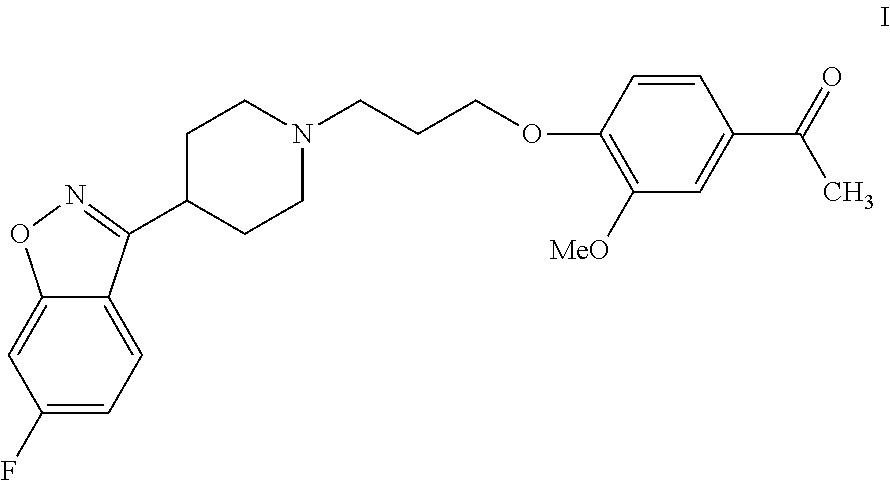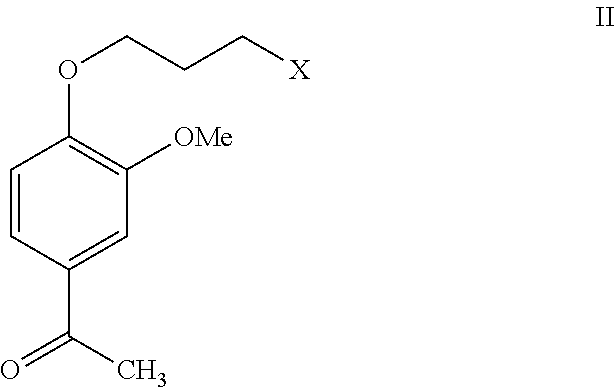Process for the preparation of iloperidone using a novel intermediate
- Summary
- Abstract
- Description
- Claims
- Application Information
AI Technical Summary
Benefits of technology
Problems solved by technology
Method used
Image
Examples
example 1
[0034]To a mixture of magnesium metal turnings (10 gm, 0.42 moles) and ether (80 ml), a mixture of methyl iodide (33.6 ml, 0.54 moles) and ether (80 ml) was slowly added at ambient temperature, and then heated for 1 hour at reflux temperature. The reaction mass was cooled in an ice bath, followed by the addition of a mixture of 4-(3-chloropropoxy)-3-methoxybenzaldehyde (40 gm, 0.17 moles) and ether (280 ml) at 0 to 5° C. The mixture was heated for 6 hours at reflux temperature. The reaction mass was cooled to ambient temperature and then poured into ice (200 gm), water (50 ml) and dilute hydrochloric acid (30 ml) mixture. The organic layer was separated and the resulting aqueous layer was extracted with diisopropyl ether (2×200 ml). The combined organic layers were washed with 2% sodium bicarbonate solution (20 ml) and water (80 ml), followed by evaporation of the solvent to produce 40 gm of 1-[4-(3-chloropropoxy)-3-methoxyphenyl]ethanol.
example 2
[0035]To a stirred mixture of potassium dichromate (11.8 gm, 0.04 moles) and water (37 ml), sulfuric acid (9 ml, 0.16 mol) was slowly added at 20° C. 1-[4-(3-Chloropropoxy)-3-methoxyphenyl)ethanol (30 gm, 0.12 moles) was dissolved in ether (120 ml) and the resulting solution was slowly added to the above mixture at 10 to 15° C. The mixture was stirred for 2 hours at ambient temperature. The organic layer was separated from the reaction mass and the aqueous layer was extracted with ether (45 ml). The resulting extracts were combined and washed with 2% sodium bicarbonate solution (15 ml) and water (30 ml), followed by evaporation of the solvent to produce a residue. The resulting residue was triturated in diisopropyl ether (10 ml) to produce 16 gm of 1-[4-(3-chloropropoxy)-3-methoxyphenyl]ethanone. The resulting solid was recrystallized from ethyl alcohol (50 ml) to yield 11 gm of 1-[4-(3- chloropropoxy)-3-methoxyphenyl]ethanone (M. P: 57.5 to 58.5° C.).
example 3
[0036]Example 2 was repeated using methylene dichloride instead of ether to yield 10.8 gm of 1-[4-(3--chloropropoxy)-3-methoxyphenyl]ethanone (M. P: 57.6 to 58.4° C.).
PUM
| Property | Measurement | Unit |
|---|---|---|
| Temperature | aaaaa | aaaaa |
| Temperature | aaaaa | aaaaa |
| Time | aaaaa | aaaaa |
Abstract
Description
Claims
Application Information
 Login to View More
Login to View More - R&D
- Intellectual Property
- Life Sciences
- Materials
- Tech Scout
- Unparalleled Data Quality
- Higher Quality Content
- 60% Fewer Hallucinations
Browse by: Latest US Patents, China's latest patents, Technical Efficacy Thesaurus, Application Domain, Technology Topic, Popular Technical Reports.
© 2025 PatSnap. All rights reserved.Legal|Privacy policy|Modern Slavery Act Transparency Statement|Sitemap|About US| Contact US: help@patsnap.com



